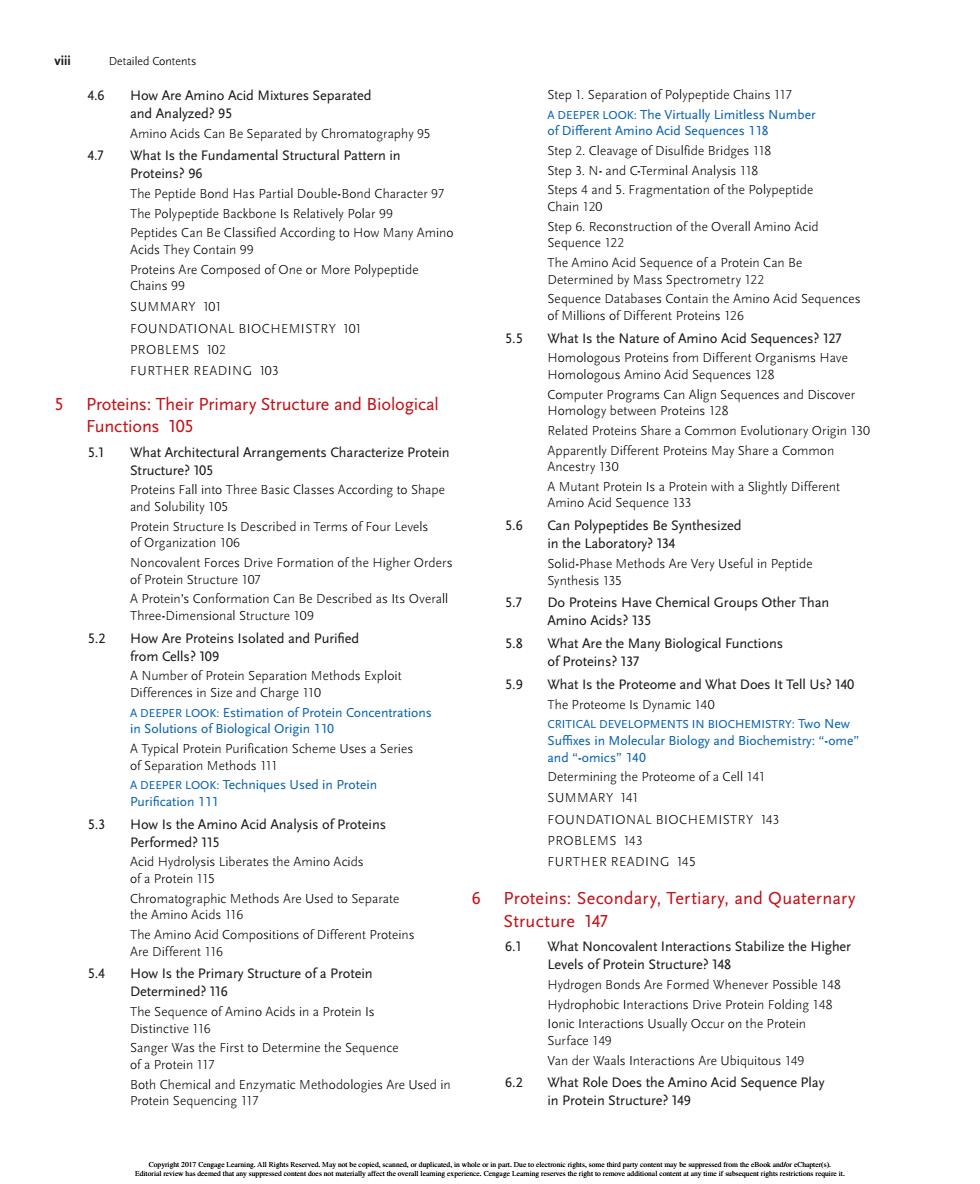正在加载图片...

Detailed Contents 4.6 Step 1.Separation of Polypeptide Chains117 eSeparated by 47 hat Ist此 Fundamental Structural Pattern in Step 2 Cleavage of Disulfide Bridges 118 Step 3.N-and CTerminal Analysis 118 Peptide Bond Has Partial Double-ond Character97 Steps 4 and 5.Fragmentation of the Polypeptide Chain 120 toHow Many Amin 8eggeconrposadcfonecrMoePohpepide Acids They Contain 99 The amino acid sea FOUNDATIONAL BIOCHEMISTRY 10 5.5 PROBLEMS 102 What Is the Nature of Amino Acid Sequences?127 FURTHER READING 103 Homologous Prote 5 Proteins:Their Primary Structure and Biological Homoloy betwen Proteins 12 equences and Discove Functions 105 Related Proteins Sharea Common Evolutionary Origin 130 5.1 What Architectural Arrangements Characterize Protein Structure?105 AMoRoegne5agenwnhaSiehyDierenl 5.6 Can poly in the Labep tides Be Synthesized tor?134 Noncovalent Forces Drive Formation of the Higher Orders Solid.Phase Methods Are Very Useful in Peptide of Protein Structure 107 Synthesis 135 proten's Can Described as Its Overall 57 Do Proteins Have Chemical Groups Other Than Amino Acids?135 5.2 5.8 What Are the Many Biological Functions of Proteins?137 ation Methods Exploit Differences in Size and Charge 110 5.9 What is the Proteome and what Does it Tell Us>140 CRITICAL DEVELOPMENTS IN BIOCHEMISTRY:TWO New Suin Molecular Biology and Biochemistry:m ADEEPER LOOK:Techniques Used in Protein the Proteome ofa Cell 141 Purification 111 SUMMARY 5.3 How Is the Amino Acid Analysis of Proteins FOUNDATIONAL BIOCHEMISTRY 143 Performed?115 PROBLEMS 143 Acid Hydrolysis Liberates the Amino Acids FURTHER READING 145 6 Proteins:Secondary,Tertiary,and Quaternary The Amino Acid Compositions of Different Proteins Structure 147 What No Are Different 116 6.1 actions stabilize the Higher 5.4 How Is the Primary Structure of a Protein Levels of Protein Structure?148 Determined?116 Hydrogen Bonds Are Formed Whenever Possible 148 Hydrophobic Interactions Drive Protein Folding 148 The of Amino Acids in a Protein Is lonic Interactions Usually Occur on the Protein Was the First to Determine the Sequence Surface 149 ofa Protein 117 Van der Waals Interactions Are Ubiquitous 149 Both Methodologies Are Used in 6.2 Protein Sequencing 1viii Detailed Contents Step 1. Separation of Polypeptide Chains 117 A Deeper Look: The Virtually Limitless Number of Different Amino Acid Sequences 118 Step 2. Cleavage of Disulfide Bridges 118 Step 3. N- and C-Terminal Analysis 118 Steps 4 and 5. Fragmentation of the Polypeptide Chain 120 Step 6. Reconstruction of the Overall Amino Acid Sequence 122 The Amino Acid Sequence of a Protein Can Be Determined by Mass Spectrometry 122 Sequence Databases Contain the Amino Acid Sequences of Millions of Different Proteins 126 5.5 What Is the Nature of Amino Acid Sequences? 127 Homologous Proteins from Different Organisms Have Homologous Amino Acid Sequences 128 Computer Programs Can Align Sequences and Discover Homology between Proteins 128 Related Proteins Share a Common Evolutionary Origin 130 Apparently Different Proteins May Share a Common Ancestry 130 A Mutant Protein Is a Protein with a Slightly Different Amino Acid Sequence 133 5.6 Can Polypeptides Be Synthesized in the Laboratory? 134 Solid-Phase Methods Are Very Useful in Peptide Synthesis 135 5.7 Do Proteins Have Chemical Groups Other Than Amino Acids? 135 5.8 What Are the Many Biological Functions of Proteins? 137 5.9 What Is the Proteome and What Does It Tell Us? 140 The Proteome Is Dynamic 140 Critical Developments in Biochemistry: Two New Suffixes in Molecular Biology and Biochemistry: “-ome” and “-omics” 140 Determining the Proteome of a Cell 141 SUMMARY 141 Foundational Biochemistry 143 PROBLEMS 143 Further Reading 145 6 Proteins: Secondary, Tertiary, and Quaternary Structure 147 6.1 What Noncovalent Interactions Stabilize the Higher Levels of Protein Structure? 148 Hydrogen Bonds Are Formed Whenever Possible 148 Hydrophobic Interactions Drive Protein Folding 148 Ionic Interactions Usually Occur on the Protein Surface 149 Van der Waals Interactions Are Ubiquitous 149 6.2 What Role Does the Amino Acid Sequence Play in Protein Structure? 149 4.6 How Are Amino Acid Mixtures Separated and Analyzed? 95 Amino Acids Can Be Separated by Chromatography 95 4.7 What Is the Fundamental Structural Pattern in Proteins? 96 The Peptide Bond Has Partial Double-Bond Character 97 The Polypeptide Backbone Is Relatively Polar 99 Peptides Can Be Classified According to How Many Amino Acids They Contain 99 Proteins Are Composed of One or More Polypeptide Chains 99 SUMMARY 101 Foundational Biochemistry 101 PROBLEMS 102 Further Reading 103 5 Proteins: Their Primary Structure and Biological Functions 105 5.1 What Architectural Arrangements Characterize Protein Structure? 105 Proteins Fall into Three Basic Classes According to Shape and Solubility 105 Protein Structure Is Described in Terms of Four Levels of Organization 106 Noncovalent Forces Drive Formation of the Higher Orders of Protein Structure 107 A Protein’s Conformation Can Be Described as Its Overall Three-Dimensional Structure 109 5.2 How Are Proteins Isolated and Purified from Cells? 109 A Number of Protein Separation Methods Exploit Differences in Size and Charge 110 A Deeper Look: Estimation of Protein Concentrations in Solutions of Biological Origin 110 A Typical Protein Purification Scheme Uses a Series of Separation Methods 111 A Deeper Look: Techniques Used in Protein Purification 111 5.3 How Is the Amino Acid Analysis of Proteins Performed? 115 Acid Hydrolysis Liberates the Amino Acids of a Protein 115 Chromatographic Methods Are Used to Separate the Amino Acids 116 The Amino Acid Compositions of Different Proteins Are Different 116 5.4 How Is the Primary Structure of a Protein Determined? 116 The Sequence of Amino Acids in a Protein Is Distinctive 116 Sanger Was the First to Determine the Sequence of a Protein 117 Both Chemical and Enzymatic Methodologies Are Used in Protein Sequencing 117 Copyright 2017 Cengage Learning. All Rights Reserved. May not be copied, scanned, or duplicated, in whole or in part. Due to electronic rights, some third party content may be suppressed from the eBook and/or eChapter(s). Editorial review has deemed that any suppressed content does not materially affect the overall learning experience. Cengage Learning reserves the right to remove additional content at any time if subsequent rights restrictions require it